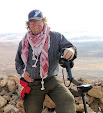Worming its way through the 75 metre high rock the Siq eventually reveals what must be the ultimate light at the end of the tunnel, the huge impressive hand-carved face of the Petra Treasury. Many of this season’s team ventured down this path for the first time today to experience for themselves the wonders of
Time and space preclude further detailed description, so let the images speak for themselves.


Meantime, three project veterans set off on field reconnaissance in a 4x4 at Shobek. There they discovered a defended halt on the branch railway line between Shobek and Unayza – the branch line that carried wood for fuel to the Hijaz railway. Further north, at Menzil, a site identified from Google Earth, the group confirmed the presence of two original Hijaz railway station buildings, beautiful preserved and alongside which were what appeared to be original rail lines, now unused. The station was defended by ring trenches on three nearby hilltops, one of which also had several fairly recent Bedouin burials on its summit. From these three redouts it would have been possible to observe the surrounding landscape for miles and to deliver devastating converging fire on any insurgence from the desert.
Finally at Unayza the team identified on the ground the two trenches which covered the approaches to the station, and also explored the Hajj route medieval and early Ottoman fort which preceded the construction of the railway.
We are discovering new sites faster than we can excavate them. The project has work for years and years to come. Exciting times ahead.











No comments:
Post a Comment